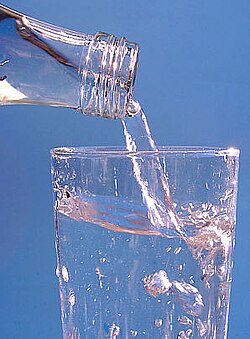Chemicals/Oxidanes

Oxidanes is a lecture from the school of chemistry. The most common oxidane on the surface of the Earth is the liquid known as water. It occurs in the atmosphere as water vapor, and as a solid usually referred to as ice.
Radiation astronomy
[edit | edit source]The image at the top of the page is a graph of the global mean atmospheric water vapor superimposed on an outline of the Earth.
Radiation
[edit | edit source]"Isotopic exchange between ice and water is found to take place in temperate glaciers. This exchange causes homogenization of deuterium in snow during summer thaws, together with a general increase in deuterium concentration."[1]
"Oxygen-isotope analyses of ice and firn from the Saskatchewan Glacier, Canada, and the Malaspina Glacier, Alaska, show that variations in ratios are likely to be of considerable value in glaciological research."[2]
Theoretical oxidanes
[edit | edit source]"Hill Formula: H2O. Molecular Weight: 18.02 g/mol. CAS registry number(s): 7732-18-5. Substance name(s): water; Wasser; Wasserstoffoxid; Eis; Wasserdampf; Oxidane; R 718; R-718; Ice; Wasser."[3]
Gases
[edit | edit source]"The major atmospheric gases on Earth, Venus, and Mars were probably CO2, H2O, and N2. [The ions from the upper parts of an atmosphere] are often suprathermal, and their interactions can produce suprathermal neutral atoms as well [The] ionopause [...] separates the bound ionosphere from an outer region in which the solar wind is diverted and flows around and past the planet. This region still contains some neutral gas, and if such atoms are ionized by solar photons or electron impact, they are swept up in the flow."[4]
Liquids
[edit | edit source]

The image on the right demonstrates that this substance's constituent parts are sticking together but not crystallizing as it flows from a bottle into a glass.
Def. a clear liquid having the chemical formula H2O, required by all forms of life on Earth is called water.
Def. of water from the metadefinition of a clear liquid:
- a clear flowing substance
- keeping or retaining no shape or definite shape
- a. except that determined by the containing receptacle
- 3. composed of H2O molecules
- a. not tending to separate from one another like those of a gas
- b. readily changing relative position
is called water.
In the image on the right impact from a water drop to contained but open water causes an upward "rebound" jet surrounded by circular capillary waves.
Glaciers
[edit | edit source]
The discoveries of water ice on the Moon, Mars and Europa add an extraterrestrial component to the field, as in "astroglaciology".[5]
Hypotheses
[edit | edit source]- Isotope concentrations in oxidanes can be used as indicators of history.
See also
[edit | edit source]References
[edit | edit source]- ↑ Bragi Árnason (1969). "The exchange of hydrogen isotopes between ice and water in temperature glaciers". Earth and Planetary Science Letters 6 (6): 423-30. doi:10.1016/0012-821X(69)90111-3. http://adsabs.harvard.edu/abs/1969E%26PSL...6..423A. Retrieved 2014-09-20.
- ↑ Samuel Epstein and Robert P. Sharp (January 1959). "Oxygen-isotope variations in the Malaspina and Saskatchewan Glaciers". The Journal of Geology 65 (1): 88-102. http://www.jstor.org/stable/30060071. Retrieved 2014-09-21.
- ↑ J Winkelmann (2007). M.D. Lechner. ed. Diffusion of water, In: Gases in Gases, Liquids and their Mixtures. 15A. Berlin: Springer-Verlag. pp. 130-1. doi:10.1007/978-3-540-49718-9_29. ISBN 978-3-540-62429-5. http://link.springer.com/chapter/10.1007/978-3-540-49718-9_29. Retrieved 2015-07-17.
- ↑ Donald M. Hunten (February 12, 1993). "Atmospheric Evolution of the Terrestrial Planets". Science 259 (5097): 915-20. http://www.csun.edu/~hmc60533/CSUN_311/article_references/Sc_Feb93_AtmosEvolTerrestPlanets.pdf. Retrieved 2014-09-21.
- ↑ Richard S. Williams, Jr. (1987). Annals of Glaciology. 9. International Glaciological Society. p. 255. http://www.igsoc.org/annals/9/igs_annals_vol09_year1987_pg254-255.pdf. Retrieved 7 February 2011.
